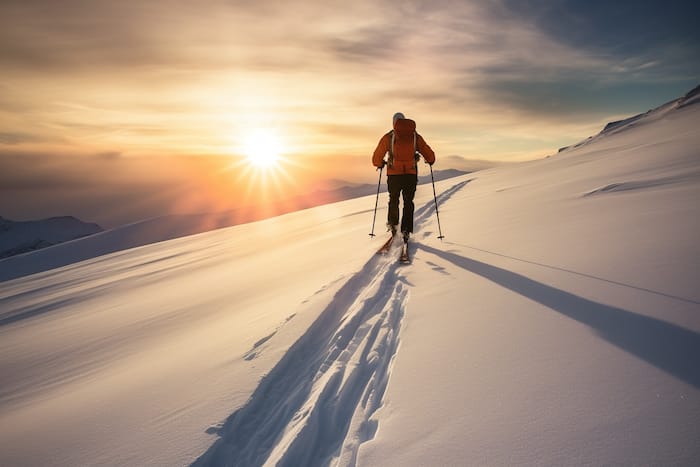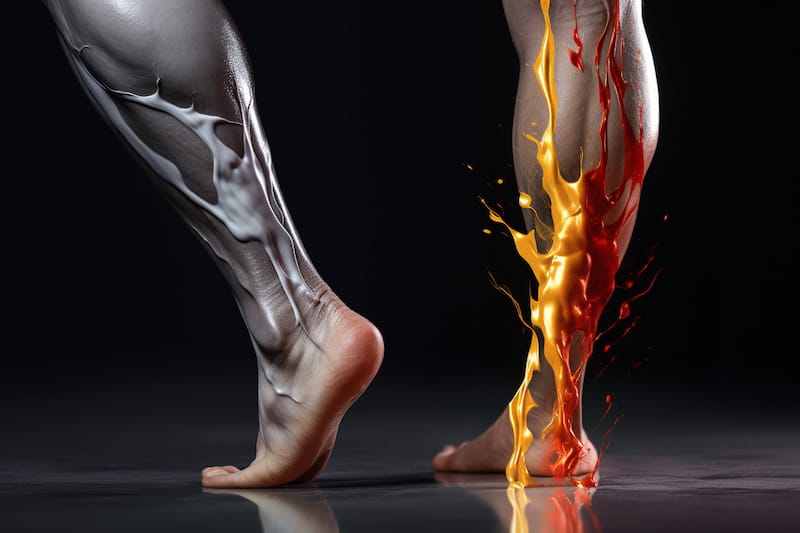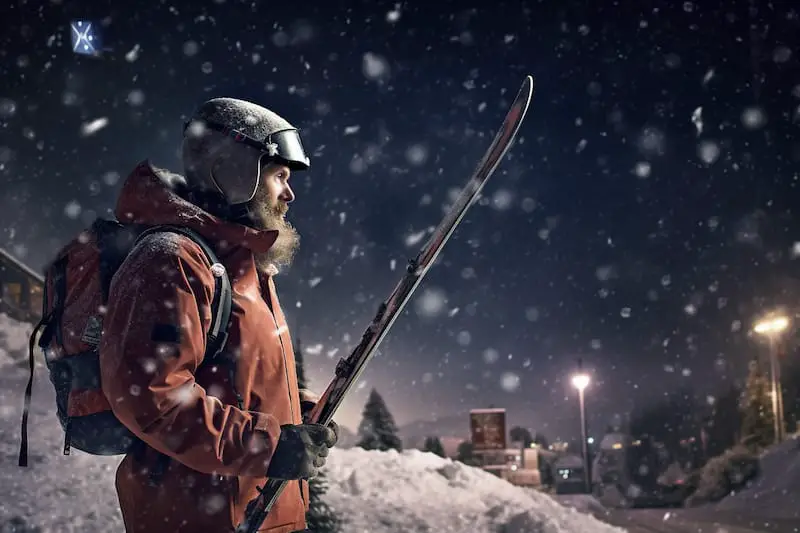Backcountry skiing requires a certain level of skill, fitness, and preparedness. However, one common problem that skiers face while backcountry skiing is blisters on their feet.
Blisters are fluid-filled bumps that develop on the skin due to friction or pressure. They can be painful and interfere with your ability to ski comfortably.
The good news is there are ways to prevent blisters from forming in the first place. In this article, we’ll discuss some useful tips for avoiding blisters while backcountry skiing so you can focus on enjoying your adventure without any unnecessary discomfort.
Choosing the Right Boots
Importance of properly fitting boots
The most important aspect of avoiding blisters while backcountry skiing is having properly fitting boots. Ill-fitting boots not only increase the risk of blisters, but they can also decrease your overall performance and even cause injury.
It’s essential to find a pair that fits snugly but doesn’t squish or pinch your feet. When trying on boots, pay attention to any areas that feel tight or uncomfortable.
Often, these are hotspots where blisters are most likely to form. Boot fitters can help you identify any problematic spots and make adjustments to ensure a proper fit.
Tips for finding the right size and fit
To find the right size and fit, it’s recommended that you try on multiple pairs before purchasing. Each brand has its own unique sizing system, so don’t assume that your regular shoe size will be the same for ski boots.
When trying on boots, wear the socks that you plan to ski in and bring any footbeds or custom orthotics you typically use. Walk around in the boots for at least 10-15 minutes to get an idea of how they feel and make sure they don’t cause discomfort or pain.
Don’t be afraid to ask for help from boot fitters if you’re unsure about what size or style is best for you. They can offer valuable advice based on their experience and knowledge.
The benefits of trying on multiple pairs before purchasing
Trying on multiple pairs of ski boots before making a purchase has several benefits. Firstly, it allows you to compare different brands and models side by side to determine which ones feel best on your feet. It also gives you a chance to test out different sizes without feeling rushed or pressured into making a decision.
By taking your time and trying on various options, you’ll increase your chances of finding the perfect pair of boots that not only fit well but also perform to your expectations. A good pair of boots is an investment in your skiing experience, and it’s worth taking the time to find the right ones.
Prepping Your Feet
The importance of keeping feet dry and clean
When it comes to avoiding blisters while backcountry skiing, the first step is to keep your feet dry and clean. Moisture is one of the main culprits behind blister formation, so it’s essential to make sure your socks and boots are completely dry before hitting the slopes. This means taking extra care to dry your feet thoroughly after showering, and not putting on wet socks or boots.
If you’re expecting a lot of snow or wet weather during your ski trip, consider wearing gaiters over your boots to help keep moisture out. Additionally, you can use antiperspirant on your feet (yes, just like you would on armpits) to reduce sweating and keep moisture at bay.
How to properly trim toenails to avoid irritation
Another way to prevent blisters while backcountry skiing is by properly trimming your toenails. Leaving them too long can cause irritation as they rub against the inside of your boots.
However, cutting them too short can also lead to discomfort and even ingrown toenails. A good rule of thumb is to trim them straight across with a pair of sharp nail clippers.
Avoid rounding the corners or digging into the sides of the nail bed. If you have trouble reaching certain areas, consider using a magnifying mirror or asking a friend for help.
Using moisturizer or talcum powder to prevent friction
Using moisturizer or talcum powder can be helpful in preventing friction while backcountry skiing. If you’re prone to blisters in certain areas (such as on the backs of your heels), apply some lotion before putting on socks and boots.
This will help reduce friction between skin and fabric. Alternatively, applying talcum powder can have a similar effect by absorbing moisture and preventing chafing.
Be sure to use a pure, unscented variety to avoid irritation and rashes. Apply it liberally to areas prone to friction before putting on socks and boots for maximum effectiveness.
How to avoid windburn while skiing?
Socks Matter
Choosing the Right Socks for Backcountry Skiing
When it comes to preventing blisters, choosing the right socks is just as important as choosing the right boots. Look for socks made specifically for skiing or other high-impact activities. Avoid cotton, which retains moisture and can lead to blisters.
Instead, opt for materials like merino wool or synthetic blends that wick away moisture and keep your feet dry. Another important factor to consider is the thickness of your socks.
While thicker socks may seem like a good idea for added cushioning, they can actually create more friction and lead to blisters. Instead, choose socks that are thin but still provide enough warmth and support.
Merino Wool vs Synthetic Materials
Merino wool has become a popular choice among outdoor enthusiasts due to its natural moisture-wicking properties and ability to regulate temperature in various weather conditions. However, synthetic materials such as polyester or nylon offer similar benefits at a lower cost.
Ultimately, the decision between merino wool and synthetic materials comes down to personal preference and budget. If you’re willing to splurge on high-quality merino wool socks, they may be worth the investment for their added durability and comfort.
How to Layer Socks to Prevent Blisters
Layering your socks can help prevent blisters by creating a barrier between your foot and boot. Start with a thin liner sock made of moisture-wicking material like polypropylene or silk.
Then add a thicker sock made of either merino wool or synthetic material on top. Make sure both layers fit snugly without any wrinkles or folds that could cause friction.
If you’re prone to blisters in certain areas of your foot such as the heel or toes, consider adding an extra layer of padding specifically designed for blister prevention in those areas. By taking the time to choose the right socks and layer them properly, you can significantly reduce your risk of developing blisters while backcountry skiing.
Breaking in Your Boots
Importance of Breaking in New Boots Before Hitting the Slopes
When you buy new ski boots, it’s important to break them in gradually before you hit the slopes. This will help prevent painful blisters from forming and ensure that your boots are comfortable for long days of skiing.
Many skiers make the mistake of wearing their new boots straight out of the box and end up with sore feet and blisters. Breaking in your ski boots can take some time, but it’s a crucial step to ensure maximum comfort while skiing.
During this process, you’ll be able to identify any areas on your feet where pressure points or rubbing occur, which could result in blisters if not addressed early on. The best way to break in your new ski boots is by wearing them around the house or while doing other activities such as walking or hiking.
Tips for Gradually Increasing Wear Time to Avoid Painful Blisters
The first step when breaking in new ski boots is to wear them around the house for short periods of time each day. Start with just 10-15 minutes at a time and gradually increase this over a period of several days or weeks until you can wear them comfortably for longer periods.
Once you’ve established some level of comfort, try wearing them while doing light activities such as walking or hiking on flat terrain before taking them out on more challenging terrain. This will give your feet a chance to adjust slowly without putting too much strain on them all at once.
Another effective technique is to wear multiple pairs of socks while breaking in your new ski boots. This helps create extra padding and reduces friction between your feet and the boot liners.
However, be careful not to overdo it as this may cause additional problems. Keep in mind that breaking in new ski boots takes time, so don’t rush the process.
It’s better to take things slow and avoid painful blisters than to push through the pain and suffer the consequences later on. With patience and persistence, you’ll end up with comfortable, well-fitting ski boots that will allow you to enjoy long days of skiing without any discomfort or pain.
Adjusting Boot Fit While Skiing
How to adjust your boots while on a ski trip
One of the most important things you can do to avoid blisters while backcountry skiing is ensuring that your boots fit correctly. However, even with the best fitting boots, adjustments may be necessary during a ski trip. Common signs that your boots may need adjusting include pressure points or hot spots on your feet, decreased range of motion in your ankles, and discomfort or pain while skiing.
If you notice any of these signs, it’s essential to make adjustments as soon as possible. The first step is to stop skiing and find a flat area where you can sit down and remove your boots.
Check for any obvious issues like debris in your boot or an improperly fastened buckle. Then, try tightening or loosening specific areas of the boot until you feel comfortable again.
Common signs that your boots need adjusting
As mentioned above, there are several common signs that indicate it’s time to adjust the fit of your backcountry ski boots. One of the most common is pressure points or hot spots on different areas of your feet.
For example, if you notice pain around your toes or heels after only a short time skiing, this may indicate that certain parts of the boot are too tight. Another sign that adjustments are necessary is decreased range of motion in your ankles.
This could be caused by improper alignment between the cuff and shell of the boot or overly tight buckles around the ankle area. It’s essential to pay attention to any discomfort while skiing and make adjustments as needed to prevent blisters from forming.
When it’s time to take a break and re-adjust
While it’s always tempting to power through discomfort while backcountry skiing, stopping to address any issues with boot fit is essential for avoiding painful blisters later on. If you notice any discomfort or pain while skiing, it’s crucial to take a break as soon as possible. Find a flat area to sit down and remove your boots.
Check for any obvious issues like debris in your boot or an improperly fastened buckle. Then, try tightening or loosening specific areas of the boot until you feel comfortable again.
It’s also important to listen to your body and take breaks before discomfort becomes too intense. Regular stretching and rest breaks can go a long way in keeping your feet healthy and blister-free while backcountry skiing.
Dealing with Blisters on the Trail
What to do if you develop a blister while skiing
Blisters are common when backcountry skiing, and it’s important to deal with them quickly to avoid further pain and discomfort. If you feel a hot spot or notice that a blister has formed, stop skiing immediately and take off your boots to assess the damage. If the blister has already popped, clean the area with an antiseptic wipe and cover it with a bandage.
If the blister is still intact, use a sterilized needle to puncture it near the edge of the blister. Then gently press out any fluid using sterile gauze or cotton balls.
Clean the area again with an antiseptic wipe and cover it with a bandage. Avoid wearing tight-fitting socks or boots over blisters as this will cause further irritation.
Essential blister care kit items
It’s important to carry a basic blister care kit in your backpack when backcountry skiing. This should include moleskin pads, sterilized needles, sterile gauze or cotton balls, scissors, medical tape, antiseptic wipes or ointment, and pain relievers like ibuprofen.
Preventative measures for future trips
To prevent blisters on future ski trips, make sure you’re using well-fitting boots and socks made from moisture-wicking materials like merino wool. Wear two layers of socks to reduce friction between your feet and boots and consider applying talcum powder or lubricating balm before putting on your socks.
Make sure you break in new boots before hitting the slopes. Gradually increase wear time over several days before embarking on long ski tours.
Final Thoughts
Blisters can be painful distractions when backcountry skiing but taking a proactive approach to foot care can make all the difference. Properly fitting boots, moisture-wicking socks, and preventative measures like breaking in new equipment can all help prevent blisters from forming. And if you do get a blister, having a basic blister care kit on hand can help keep you comfortable and keep your ski trip on track.


